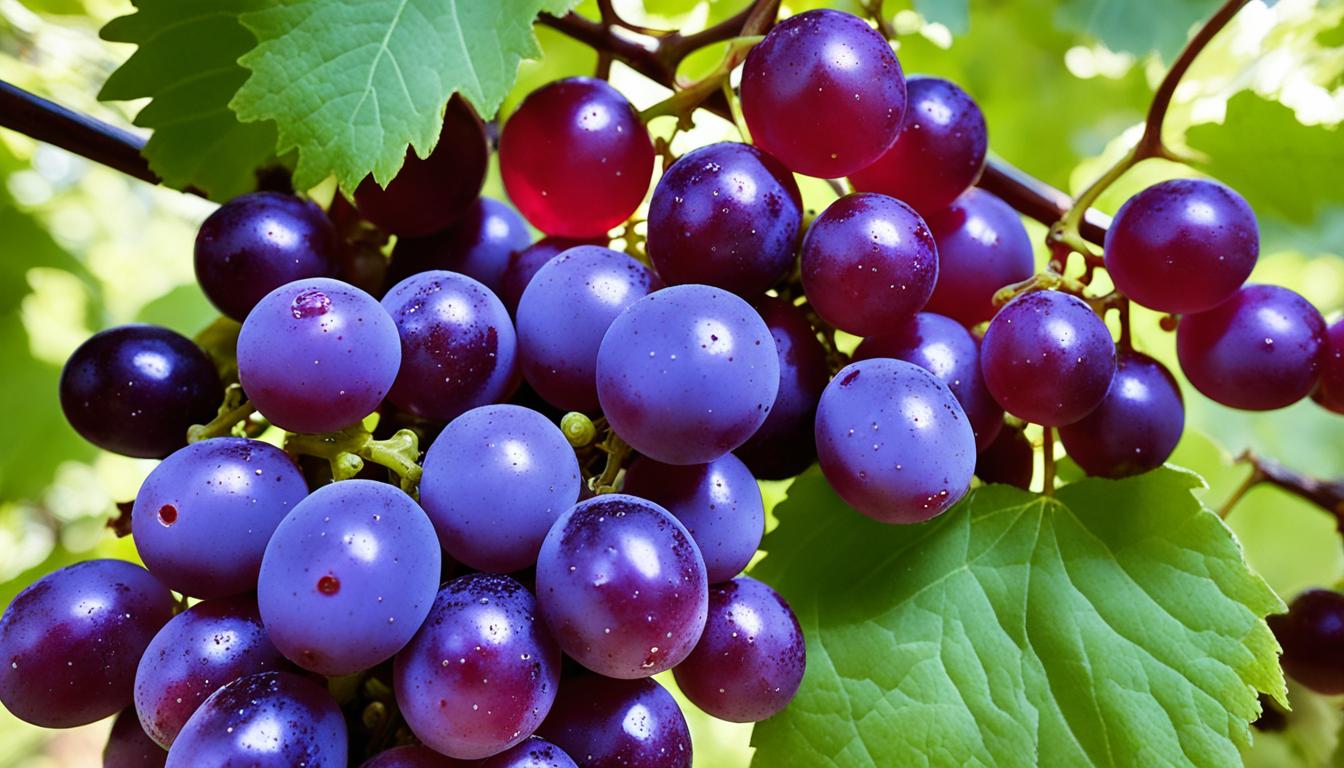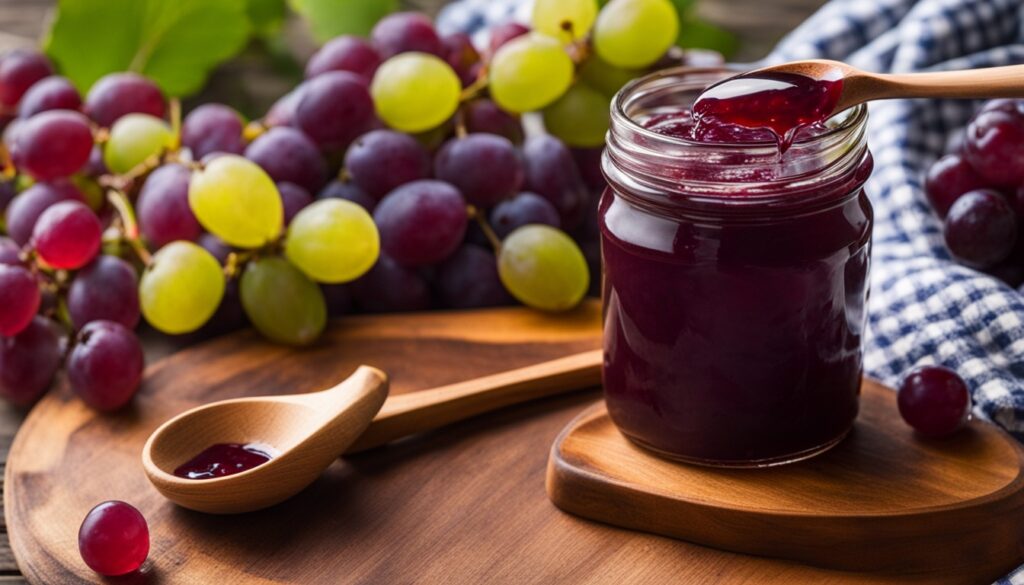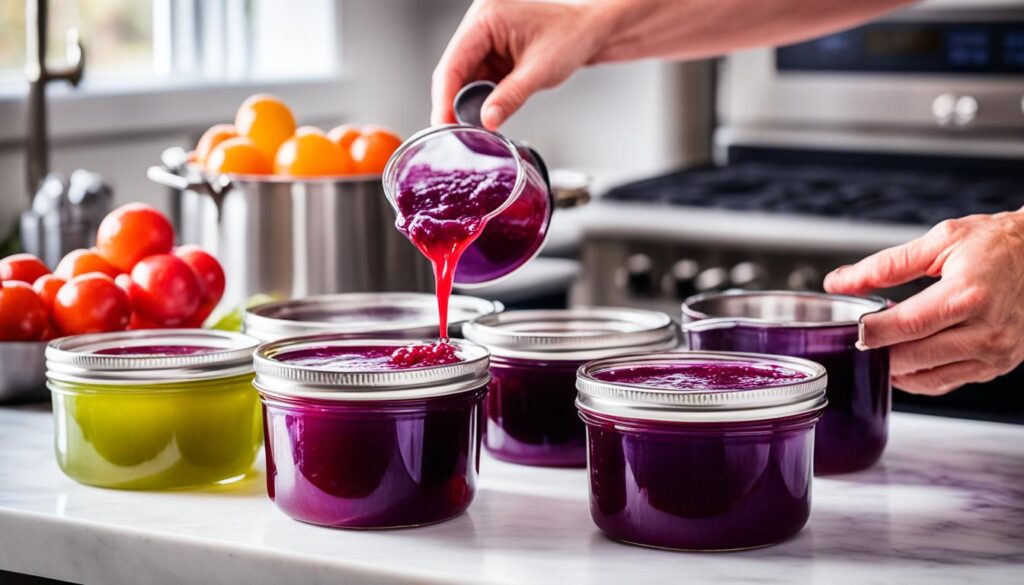Homemade Muscadine Grape Jelly: Easy Recipe Guide

Have you ever wondered how to capture the essence of the South’s beloved muscadine grapes in a homemade jelly? Look no further! This comprehensive guide will walk you through the simple steps to create a delectable batch of homemade muscadine grape jelly that will have your taste buds dancing with delight. Discover the secret to unlocking the rich, tart flavors of these unique grapes and impress your friends and family with your homemade culinary skills.
Key Takeaways
- Learn the easy process of making homemade muscadine grape jelly
- Discover the key ingredients and equipment needed for the perfect jelly
- Explore the differences between cultivated and wild muscadine varieties
- Uncover the secrets to canning and storing your homemade muscadine jelly
- Enjoy the unique tart and sweet flavor of this Southern specialty
The Ultimate Guide to Making Homemade Muscadine Grape Jelly
Muscadine grapes are a unique Southern variety that thrives in the hot, humid climate. These grapes are larger than traditional table grapes and come in both purple and bronze/green hues. Understanding the differences between wild and cultivated muscadines will help you select the best grapes for your jelly-making endeavors.
What is a Muscadine Grape?
Muscadine grapes, also known as scuppernong grapes, are native to North America and have a rich history in the Southern United States. These grapes are renowned for their high antioxidant content, contributing to their overall health benefits. Muscadine grapes are larger in size compared to traditional table grapes, and their distinct flavor profile ranges from sweet to tangy.
Cultivated vs. Wild Muscadine Varieties
While wild muscadine grapes can be found growing in the forests, there are also many cultivated muscadine varieties developed for enhanced flavor and size. Cultivated muscadine grapes are typically grown in slightly acidic soils, particularly in regions like East Texas, where the humid climate and pest resistance of the grapes make them an ideal crop.
When selecting muscadines for your jelly-making, it’s important to consider the differences between wild and cultivated varieties. Cultivated muscadines often have a more consistent flavor and larger fruit size, making them a preferred choice for jelly recipes. However, wild muscadines can also add unique and complex flavors to your homemade jelly.
“Muscadine jelly originated in the southeastern United States and has a rich history dating back centuries.”
To make muscadine grape jelly, you will need approximately 3-4 pounds of fresh muscadines to obtain 4 cups of juice. The jelly can be stored for up to one year when canned properly, or up to three months when refrigerated.
How to Make Muscadine Grape Jelly: Step-by-Step Instructions
Homemade muscadine grape jelly is a delightful and flavorful preserve that captures the essence of this unique Southern fruit. Making your own muscadine grape jelly is a rewarding process that allows you to control the ingredients and customize the taste to your preferences. In this step-by-step guide, we’ll walk you through the essentials of creating a batch of this tasty jelly.
Ingredients and Equipment Needed
To make muscadine grape jelly, you’ll need the following ingredients and equipment:
- 5 lbs of fresh muscadine grapes
- 4 1/2 cups of granulated sugar
- 1 package of dry pectin
- A 6-quart heavy bottom pot and a 4-quart heavy bottom pot
- A large bowl, sieve or food mill, and potato masher
- A canning pot with a lid, wide mouth funnel, jar lifter, and lid wand
Step 1: Preparing the Muscadine Grapes
Start by thoroughly washing the muscadine grapes. Gently remove the stems and separate the grapes from their skins. Place the skins in one bowl and the pulp in another. Using a potato masher, crush the pulp to extract the juice.
Step 2: Extracting the Muscadine Juice
In a large pot, combine the crushed grape pulp and skins. Bring the mixture to a boil, then reduce the heat and simmer for about 10 minutes, stirring occasionally. Once the grapes have softened, use a sieve or food mill to strain the juice from the solids.
Step 3: Cooking the Jelly Mixture
Measure the extracted muscadine juice, and for every 5 cups of juice, add 4 1/2 cups of granulated sugar and 1 package of dry pectin. Bring the mixture to a rolling boil, stirring constantly. Once it reaches a full boil, continue cooking for 1 minute, still stirring constantly.
Carefully pour the hot jelly mixture into sterilized canning jars, leaving 1/4 inch headspace. Wipe the rims of the jars and secure the lids. Process the sealed jars in a boiling water bath for 10 minutes to ensure proper canning.
Once the jars have cooled completely, the muscadine grape jelly is ready to be enjoyed. This recipe yields approximately 8 (8-ounce) jars of delicious homemade jelly. Savor the unique and vibrant flavor of muscadine grapes in your very own handcrafted preserves.

How to Make Muscadine Grape Jelly: Canning and Storage Tips
Once you’ve cooked up a batch of delicious homemade muscadine grape jelly, it’s time to preserve your tasty creation for long-term enjoyment. Proper canning and storage techniques are essential to ensure your muscadine jelly stays fresh and flavorful for up to a year.
Canning Muscadine Grape Jelly
To can your muscadine grape jelly, you’ll first need to sterilize your jars and lids. Wash the jars and lids in hot, soapy water, then place the jars in a 190°F oven for at least 10 minutes to sterilize them. Bring the jar lids to a simmer in a small saucepan to soften the sealing compound.
Next, carefully ladle the hot jelly mixture into the sterilized jars, leaving a 1/4-inch headspace at the top. Wipe the rims of the jars clean, then place the lids and rings on top, tightening them just until fingertip-tight.
Finally, process the sealed jars in a boiling water bath for 5 minutes to ensure a proper seal. Once the jars have cooled, you should hear the satisfying “pop” of the lids sealing. Any jars that do not seal should be refrigerated and used first.
Storing Muscadine Grape Jelly
- Store the sealed jars of muscadine grape jelly in a cool, dark place, such as a pantry or basement, for up to 1 year.
- Avoid exposing the jars to direct sunlight or heat, as this can cause the jelly to discolor and lose its flavor over time.
- Once a jar is opened, store it in the refrigerator and use within 3-4 weeks.
With these simple canning and storage tips, you can enjoy the sweet, tangy goodness of your homemade muscadine grape jelly for months to come. Savor the taste of summer all year round!

How to Make Muscadine Grape Jelly
Making homemade muscadine grape jelly is a rewarding process that allows you to capture the unique and delightful flavors of this beloved Southern fruit. Muscadine grapes, known for their sweet taste and robust texture, are the key ingredient in creating a truly exceptional jelly that can be enjoyed on biscuits, toast, or as a versatile condiment.
The muscadine jelly-making process involves several essential steps, each crucial for achieving the perfect balance of sweetness, acidity, and texture. Let’s dive into the details of how to craft your own batch of homemade muscadine grape jelly.
Preparing the Grapes
The first step in making muscadine grape jelly is to carefully prepare the grapes. Rinse the muscadines and remove any stems or damaged berries. Proper texture in jelly requires the correct combination of fruit, pectin, acid, and sugar. One-fourth of the fruit used should be under-ripe to compensate for the lower pectin content in fully ripe fruits.
Extracting the Juice
Next, you’ll need to extract the juice from the prepared muscadine grapes. This can be done by gently mashing the grapes and then pressing the mixture through a fine-mesh strainer or cheesecloth. Adding one or two tablespoons of lemon juice helps counterbalance low acid levels in fruits, aiding in the gel formation.
Cooking the Jelly Mixture
In a large saucepan, combine the extracted muscadine juice with the appropriate amount of sugar. Sugar plays a crucial role in flavor, gelling, and spoilage prevention in homemade jellies. Bring the mixture to a boil, stirring constantly to prevent burning. Once the mixture reaches 220°F, remove it from the heat. Overcooking pectin can lead to thin jelly and hinder proper gelling.
Canning and Storing
To ensure the longevity and safety of your homemade muscadine grape jelly, it’s essential to properly can and store the final product. Carefully pour the hot jelly mixture into sterilized jars, leaving a 1/4-inch headspace. Water bath canning is essential to prevent health issues related to mycotoxins and ensure product safety. Process the sealed jars in a water bath for about 5 minutes, then remove and allow them to cool completely before storing in a cool, dark place.
By following these steps, you can create a delightful batch of homemade muscadine grape jelly that captures the essence of this Southern specialty. Enjoy the sweet, bold flavor of your handcrafted jelly on your favorite baked goods or as a unique condiment that will impress your family and friends.
Conclusion
Homemade muscadine grape jelly is a delightful Southern tradition that captures the essence of the region’s bounty. By following the easy-to-understand instructions in this guide, you can create your own batch of this unique and flavorful spread. Whether you use wild-harvested or cultivated muscadine grapes, the end result is a jelly that beautifully showcases the vibrant, sweet-tart notes of this beloved fruit.
Enjoy your homemade muscadine grape jelly on biscuits, toast, or as a special condiment, and savor the taste of the South. This versatile preserve not only adds a touch of Southern charm to your kitchen but also celebrates the rich agricultural heritage of the region. With a few simple steps and some patience, you can bring the essence of the muscadine grape to your table, sharing the joy of this homemade delight with family and friends.
Homemade muscadine grape jelly is a true testament to the flavors of the South, and this guide has provided you with the tools to masterfully craft your own batch. Embrace the process, revel in the vibrant hues, and indulge in the mouthwatering goodness of this timeless Southern treasure.







